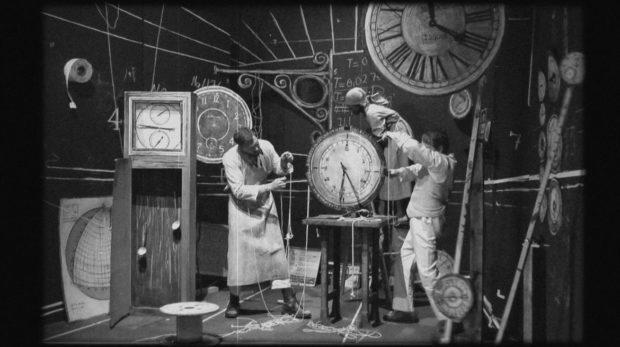You have no items in your cart. Want to get some nice things?
Go shopping
Born in Johannesburg in 1955, William Kentridge grew up in apartheid South Africa, the son of two lawyers. His show Thick Time, at the Whitechapel Gallery until January 15 2017, features his work from the last 13 years and is his first major show in the UK in 15 years. Kentridge’s art is incredibly intricate and not at all easy to categorise. He uses painted and drawn images, sounds, film, mechanised puppets, and objects, layering them on top of one another and splicing them together into one messy, mixed-media whole. The effect is stupendous.
The Refusal of Time, inspired by his conversations with American scientist Peter Galison about the theories of time, is the first piece in the exhibition. A mechanised pump, taller than you or me and which Kentridge calls “a breathing sculpture or ‘elephant'”, stands and works away in the middle of the room while black and white images play out on the five screens around it. We see a couple move from domestic bliss to mock serious fighting while a kind of dystopian jazz plays the soundtrack to their life, before cutting to a bodiless hand and a pen drawing on acetate laid over the top of a video of a man – Kentridge himself.
An Orwellian voice says something about the pips on the radio and the phrase “Here I am” is repeated over and over until its meaning becomes unclear. We see scientists around the world exploring space and time from their labs and then Jesus on his cross in space. The unknown becomes a receptacle for shared memory, an archive of events that happen on earth. Here is art, mathematics, mechanics, philosophy, physics; there is history itself and histories of all these fields. It’s as if Kentridge has strapped us into a time machine that takes us on a tour of the universe in which we live. Just as in life, it’s impossible to take everything in, but you’re aware of it all, its hugeness, its complexities, the beauty and horror and ridiculousness.
Second-Hand Reading is the most moving piece in the show. The pages of Cassell’s Cyclopaedia of Mechanics have been commandeered for a flip book through which we see the artist walking. Objects fill his day – or perhaps it is better to say his time – coffee percolators, flowers, trees, bicycles; messages such as “A fault to be dealt with later” and “Tear and repair” seem at once random and expected, showing the patterns of a life. It’s a solitary tale but one to which we can all relate, and therein lies its emotional power. The main focus of the piece is a video of the pages flipping by, but you can also look through the book yourself in The Tapestry Library next door, where three huge tapestries bring together the ideas of empire and revolution, and the absurdity of both, with quiet certainty.
Kentridge’s work is infused with references to other schools of thought and works of art. Right Into Her Arms is what the exhibition guide calls a “miniature model theatre”: a sort of Dadaist reimagining of scenes from Alban Berg’s between-the-wars opera Lulu. Two rectangular boards move back and forth on a runner, acting out a scene between a couple. We assume they are a man and woman because the text which flashes up conveys an element of unwanted male force, but in fact they are completely without gender and the reduction of two humans to pieces of rectangular card framed with plywood puts life on earth into surreal perspective. It’s funny and surprisingly sexy and not a little unsettling.
Throughout the exhibition, Kentridge’s artistry is inescapable, and in 7 Fragments for George Méliès, Day For Night and Journey To The Moon he explores what it means to create that work. Nine videos are projected onto the walls of a closed off room, each showing the artist at work. There he is with a coffee and a blank page, there he puts pen to paper, over there a finished landscape. Yet the art seems to create itself: as his brush moves towards the paper the ink leaps onto the page. On one of the screens, we see Kentridge remaking a self-portrait that has been defaced. Of course, it is simply a video in reverse, but the effect is as if he is creating himself from nothing, as if through art the self is born.
This is an exhibition with substance, not just art in the conventional sense; it is theatre, poetry, opera and film, all of it executed with an aliveness and sensitivity to our world and all its dimensions at which the mere mortal’s mind boggles. It is the moment after that confusion, when you have allowed your mind to empty of what fills your own time, when Kentridge’s work sings with the thickness of all time.![]()
William Kentridge: Thick Time continues at the Whitechapel Gallery until January 15 2017. Tickets are available from £11.95.

About Rosanna Boscawen
Rosanna Boscawen's short stories have been published by Liar's League and .Cent magazine, and she has written for The New York Observer, Prospect magazine and The Observer New Review. She grew up in Suffolk and now lives in London.





One comment